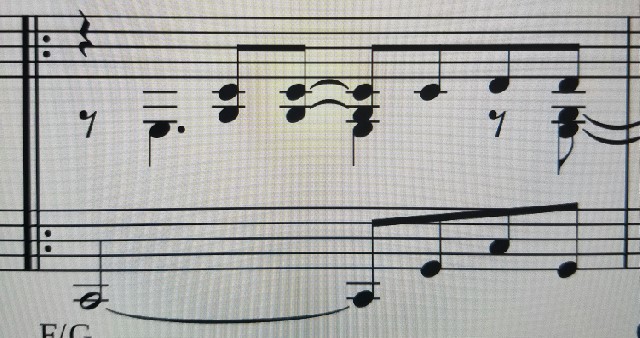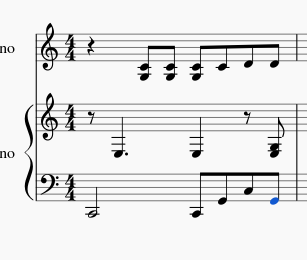It seems there are too many notes in the treble clef below. The time signature is 4/4 yet there it starts with a quarter rest, then a dotted quarter, then 6 eighth notes. This adds up to more than four quarter notes. What does this mean? And what is the meaning of the eighth rest below the quarter rest at the beginning of the measure?
-
3I feel this is almost certainly a duplicate, but my searching abilities are failing me.– endorphCommented Feb 6, 2017 at 0:39
-
This is poor quality engraving (i.e. it's the sort of junk produced by "market leading" software when used by people who don't know any better!). The first 8th-rest applies to the staff as a whole, so it should be at its normal position in the middle of the staff. There should then be a second 8th-rest above the dotted-quarter E. If it had been notated like that, the OP wouldn't have had a question to ask! Even if two completely separate voices were preferred for some reason, there is no reason to raise the quarter rest above its normal position when the 8th rest is moved so low.– user19146Commented Feb 6, 2017 at 1:09
-
4@alephzero Honestly I find this more readable than the notation you suggest because in this notation each voice has its own rests. But that might depend on which style you are used to.– Sumyrda - remember MonicaCommented Feb 6, 2017 at 4:56
-
As endorph pointed out, this is on of many questions we have on this exact topic. We need to do a better job of linking and closing duplicates and make them easier to find.– Dom ♦Commented Feb 6, 2017 at 15:28
-
@Dom Perhaps we should edit titles to contain the correct terminology once a question is answered?– endorphCommented Feb 6, 2017 at 22:39
3 Answers
What you're looking at is two separate voices. In more complicated music, we sometimes write out two independent lines (or voices) on a single stave.
The first voice in this piece comprises the crotchet rest, followed by the quavers C+G, C+G tied to another C+G, then C, D and D again. This adds up to four crotchets.
The second voice comprises the quaver rest, the dotted crotchet E, the crotchet E, the quaver rest, and the G+E quaver that is tied into the next bar. This also adds up to four crotchets.
There is only a single voice on the bass stave.
The reason I know this, is because of the direction of the note stems. See how the first voice only has stems that point upwards? The second voice all points downwards. I know which rests to associate with each voice through the vertical positioning of the rests on the stave, and also because there's only one interpretation which will allow the bar to add up.
-
This is also what I see when I read this measure. It's pretty normal, but hard to read at a glance.– coteyrCommented Feb 6, 2017 at 11:54
The music notation is correct, but possibly a bit odd if your not used to it. Seperated out it would look like this:
You can here it at This link Some guesses were made obviously. I I left out some of the stuff, but you get the point.
I believe there are two different voices in the top staff; The higher voice starts with a quarter rest then synchs up with the lower voice on the "c" and plays six more eighth notes making a full measure.


